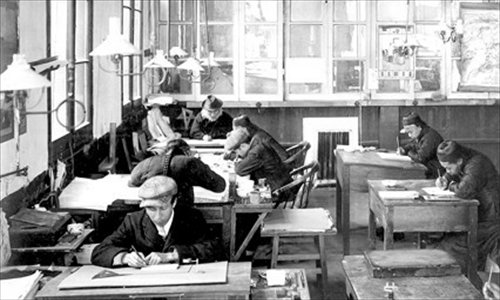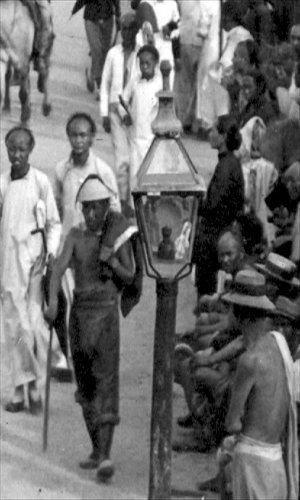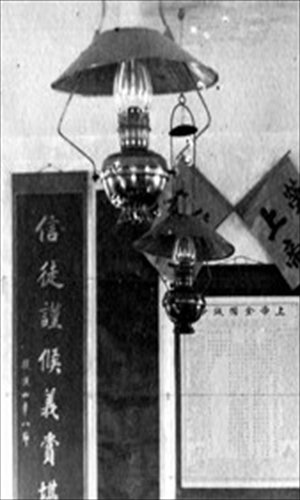The end of the night

Traditionally Chinese families used candles or oil lamps as a source of light at night. Lamps used bean or rapeseed oil but most streets were plunged into darkness when the sun had set.
Sometimes at important road intersections oil lamps were installed to help night travelers but for the most part lighting the streets was considered a waste of money - people went to bed when the sun went down and seldom ventured outside. Moonlight was enough for most people and it was free.
When the British, French and other countries established concessions in Shanghai after the First Opium War in 1842, the new authorities began considering street lighting in the concessions. In 1845 the British Consul in Shanghai ordered that tenants in the concessions to begin erecting street lights.
Too expensive
The early lamps were oil lamps fueled by mixtures of candle grease, animal fats, vegetable oils - the more effective and efficient kerosene was considered too expensive. Records of the day noted that the cost of running a kerosene lamp was four and a half yinyuan (or silver dollar) a month - three times the cost of a lamp fueled by oil or fat. Kerosene lamps were mostly used indoors although the city did have some kerosene street lights.
But then gas arrived and the city brightened up at night as gas lighting replaced the old oil lamps.
Gas lights had several advantages: they were about three times as bright as oil lamps; they could be turned on with simple twist of a switch and there was no need to add more oil to keep them working; and because the gas arrived in underground pipes it was safer and easier to maintain.
In 1863, the Shanghai Gas Company, the first gas production plant in China, was established at the southern bank of Suzhou Creek to provide gas and lay the pipelines to distribute the gas. This was solely for lighting - gas in those days was not used for cooking.
In June 1865, the gas company suggested it could erect street lamps powered by its gas. But most of the 200 respondents of a public survey opposed the notion complaining that it would cost too much to maintain, it would result in higher taxes or because the lights would be fueled by gas which was an unknown substance to them.
The authority finally agreed to let the gas company build 10 gas street lamps as a trial on Nanjing Road from Henan Road to the Bund, a busy area with plenty of traffic and constant crowds. The public could judge for themselves if the gas lights were a good thing.
On December 18, 1865, the first gas street lamps flared into life on Nanjing Road. The experiment was deemed a success and, at a lower price than it first proposed, the gas company signed a contract to light all of the streets in the former British concession.

Crime plummets
It was reported enthusiastically after the lights were switched on that the crime rate in the city plummeted but there were no official statistics to back this claim.
The French Concession followed the British in March 1867 with 169 gas street lights brightening the streets there, powered by a gas plant built near today's Yongshou Road and Guangxi Road South. By the end of 1881, there were 489 gas street lights in the French Concession and the International Settlement. Other gas lights were to be found in hotels, stores, tea houses, theaters and homes. Gas brought light to the town - but not for long.
In the US in 1879 Thomas Edison produced the first practical working light bulb (although there are vague reports of a foreign engineer in Shanghai producing, in an old warehouse in Hongkou district, his own incandescent light bulb powered by a steam engine generator in the same year).
In 1882, a businessman called R W Little, who had established the Shanghai Electric Company, proposed supplying electric street lights to the city. Like the trial of gas lighting before, he was given permission to have a public demonstration of his electric street lighting. In June that year at Wusong Fort in Baoshan crowds watched as the city's first electric street light was switched on. Reports from the day noted that it seemed as though the area was bathed in daylight. One newspaper predicted confidently (and correctly) that in the future the entire city would be lit by electricity.
People were amazed at the brightness of electric lights and they were gradually introduced to theaters, tea houses and restaurants. In 1883 author Huang Shiquan noted that lights were kept on night after night and the city was "ever bright."
However, electricity also had its critics. At first the authorities doubted that it was safe. Officials were reported in a newspaper saying that they feared electricity would kill people, set homes ablaze and could destroy the city. Some city officials took to visiting homes where electricity had been installed and banning the householders from using it. The bans were eventually lifted after foreign consuls intervened.

Not dependable
It took time for electricity and electric lighting to become accepted. It was more expensive than gas - it cost about twice as much to light a room with electricity as it did with gas. It was also not as dependable with generators frequently breaking down and needing repairs. The inefficiency of the early power stations also limited the areas that could be supplied with electricity.
The Shanghai Gas Company was also fighting the introduction of electricity. The war between the two companies began in 1882 and continued for years.
In the early days, because electric lighting was not accessible to everyone and everywhere, the electric company claimed electric lighting would always be struggling to make any profits. The situation brightened for the electric side when the new tungsten bulbs were introduced in the early 20th century making the bulbs brighter, and more reliable.
In the end, electricity won the favor of the authorities and even though it was more expensive it became the accepted mode of lighting. The last gas light in the city street was dismantled in 1935. The gas company survived and prospered by providing gas for cooking, not lighting.
The first neon lights arrived in Shanghai in 1921, and neon lighting certainly added color and rhythm to the city's nightlife as the major form of outdoor advertising. But that, too, had its day. In 2008, the last 24 neon arches that had been a centerpiece on Huaihai Road Middle for 20 years were turned off and taken down. Nowadays, it is difficult to find neon lights in the city - LED (light-emitting diodes) bulbs are the choice of most present-day lighting display artists and designers.